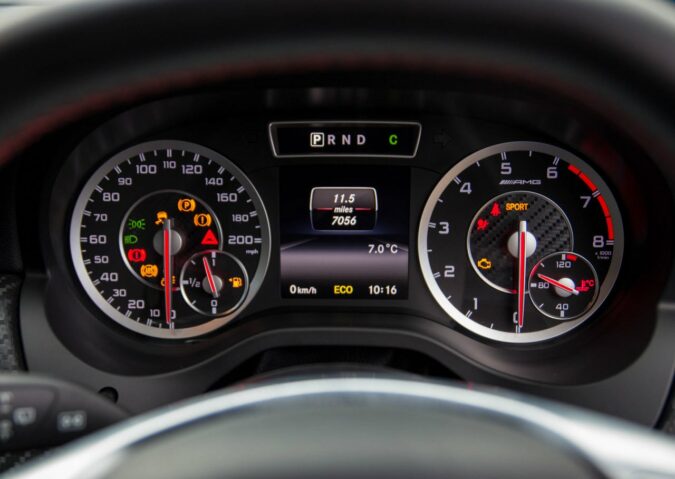The purpose of a throttle position sensor is to ensure that your vehicle’s engine receives the right amount of air and fuel to perform at its best. It is placed on the butterfly spindle and is an important part of your vehicle’s fuel management system. When this sensor fails, you’ll notice clear throttle position sensor symptoms that impair the performance of your car.
At the first sign of failure, this component must be replaced. Depending on what’s wrong, a faulty throttle position sensor might either leave you stranded on the side of the road or cause your vehicle to accelerate uncontrollably.
The throttle body fails to work properly when the throttle position sensor in a car fails to function properly. If left untreated, a faulty throttle position sensor might cause your car to shake uncontrollably. This, in turn, puts a lot of strain on the motor mount and transmission mount, eventually leading it to fail and needing you to spend more money to fix these problems. As a result, it’s critical to become aware of some of the key throttle position sensor symptoms that need to be replaced.
- How Does It Work?
- What Happens When It Fails?
- Symptoms
- How to Perform a Test?
- Throttle Sensor Replacement?
- Is it Expensive?
- Is it Worth Repairing?
- Final Verdict
What Is The Purpose Of A Throttle Position Sensor?
The throttle position sensor is attached to the throttle body and monitors the throttle position as well as the amount of air entering the engine at any one time. Actually, the throttle body is responsible for controlling the amount of air that enters the engine. The throttle body flap opens further as you press harder on the accelerator, allowing more air in.
The throttle position sensor monitors the position of the throttle body flap and relays this data to the ECU. The ECU may use this information to calculate how much fuel is required to match the amount of air entering the engine and alter the injector fuel output accordingly.
How Does A Throttle Position Sensor Work?
Three wires are used in a large percentage of throttle position sensors. You can have a 4-wire or even a 5-wire TP sensor, depending on the manufacturer of your vehicle. The throttle flap position is measured via a potentiometer inside all TP sensors. Potentiometers are variable resistors with a resistance material and a rotating contact (commonly referred to as a “wiper”).
Due to its electrical structure, throttle position sensors require at least three wires: one for the reference voltage, one for the returning voltage, and one for the ground. Internal switches in less common sensors, such as the 4-wire and 5-wire TPS, report idle or wide-open throttle positions. The ECU delivers a 5V reference voltage to all of its analog sensors every time the ignition is turned on.
One of TPS’s terminals receives the reference voltage, passes via the potentiometer’s resistive material, and then returns to the ECU via another terminal. The electrical circuit is completed by the third terminal (ground). The electronic control unit uses the sensor’s returned signal to calculate the current throttle position, commonly expressed as an aperture percentage or angle.
What Happens If Your Throttle Position Sensor Fails?
There are numerous causes for a bad throttle position sensor, as well as numerous throttle position sensor symptoms. When this happens, it results in poor fuel economy and, more importantly, puts you and other drivers in danger. When changing gears or altering the base ignition timing, it might also cause issues.
The TPS can collapse in stages or all at once. When the TPS fails, the check engine light will usually illuminate to alert you to the problem. Furthermore, most carmakers include a “limp home” mode of functioning with decreased power if your engine fails. This is designed to allow a driver to safely exit a congested route.
And if you notice a problem with your TPS, all you have to do is replace it as soon as possible.
When replacing the TPS, you’ll need to clear any related fault codes and maybe reprogram the new TPS module’s software to work with other engine management software. Bringing your car to a qualified mechanic who can check and install the appropriate replacement part is the best option.
Throttle Position Sensor Symptoms
A throttle position sensor measures the position of the throttle valve on the throttle body. It detects the movement of the throttle valve and turns it into electronic impulses. With time, the sensor produces a variety of problems.
The challenge now is how to tell if your throttle position sensor is malfunctioning. Simply continue reading to determine whether or not your throttle position sensor is defective. The throttle position sensor symptoms are listed below:
1. Slow Acceleration Rate
The throttle position sensor could be to blame if your automobile does not seem to accelerate when you push the accelerator pedal. Your car’s control module is confused by a malfunctioning TPS, and it doesn’t know how much air and fuel it needs to provide. The car will not accelerate adequately if there is insufficient air or gasoline.
If the TPS hasn’t totally failed, the problem may appear to be intermittent. It may occasionally provide false data, causing your fuel management system to alternate between using the proper quantity of fuel and using an excessive amount.
2. Hesitation Or Jerking Drive
Bad throttle position sensor symptoms might cause hesitation or jerking. While driving, you will notice the automobile stuttering or jerking. The ECU will receive inaccurate data from a defective throttle position sensor. As a result, the engine control unit (ECU) has no idea how far the throttle valve should be opened, causing the car to jolt or hesitate when driving.
3. The Car Will Not Exceed A Certain Speed Limit.
The throttle position sensor symptoms may include times when the car won’t go beyond a specific speed restriction. It’s a perplexing indicator if your car doesn’t accelerate even when you completely compress the accelerator pedal.
The throttle position sensor would not be able to communicate all of the data to the ECU if it was defective. As a result, the ECU may not fully open the throttle valve, preventing the vehicle from exceeding a specific speed limit.
4. The Car Accelerates On Its Own
This is a dangerous throttle position sensor symptom because the automobile may speed up on its own without the driver’s knowledge. It happens most often while you’re driving, and your automobile accelerates without you pressing the gas pedal. It has the potential to cause an accident.
A defective throttle position sensor will not be able to deliver its data at the appropriate time to speed up the automobile, and as a result, the car will abruptly speed up when you are not intending to do so.
5. Engine Power Is Insufficient
Among the throttle position sensor symptoms is a loss of engine power in your vehicle. Because if your throttle position sensor fails, your car will go into a safe mode, limiting heavy acceleration and speed and resulting in a loss of engine power.
6. Condition Of Inability To Start
A malfunctioning throttle position sensor can cause a no-start scenario when you can only crank the engine and not turn it over. When the ECU shuts the fuel injectors and deprives the vehicle of power, a condition known as no injector pulse or a dysfunctional fuel system, this type of issue can occur.
If you try to start the engine in any vehicle while completely flooring the throttle, it will simply not start since the ECU stops the gasoline introduction when the throttle is wide open. A malfunctioning throttle position sensor, which sends a false indication, can also produce a wide-open throttle. This would prevent fuel injectors from firing, effectively lowering engine power.
7. Weak Idle
A faulty throttle pedal position sensor causes your car’s idle to surge or the engine to not maintain a steady idle. A faulty throttle pedal position sensor will send erroneous data to the ECU, resulting in variable idle speed and, in certain cases, unexpected stalling.
8. Issues With Transmission
One of the more dangerous throttle position sensor symptoms is transmission problems. By preventing sufficient speed changes, a defective throttle position sensor may cause erroneous shifting in an automatic transmission. The throttle position sensor transmits a reading to the ECU, just as it does for the ECU to compute fuel mixes so that the gearbox can be adjusted precisely with the throttle arrangement.
When the throttle position sensor fails intermittently and sends incorrect readings, the automatic gearbox may have difficulty shifting gears or even cause unexpected jerks. Aside from the transmission and engine being irreversibly damaged, this can result in exceedingly dangerous and catastrophic scenarios.
9. Influences Fuel Economy
This is one of the more prevalent throttle position sensor symptoms. You may find that you are filling up your automobile with gas more frequently than before. This could be due to your vehicle running too rich, which means it is consuming more fuel than it needs.
If your position sensor is malfunctioning and reading too high, too much fuel is being poured into the cylinders, resulting in some fuel being wasted. Poor fuel efficiency can indicate a variety of issues, like broken spark plugs or filthy fuel injectors, so it’s best to have your automobile inspected by a specialist to establish the root of the problem.
10. The Check Engine Light Illuminates
Your car’s computer, believe it or not, is quite intelligent. car’s computer continuously gets a large amount of data from your vehicle’s numerous parts and sensors. It immediately recognizes an issue if any of the data it receives appears to be abnormal. It does this by activating your check engine light, which alerts the driver that there is an issue.
If your check engine light comes on, it could be due to a defective TP sensor. However, this warning light might also indicate a variety of other issues. If this light appears on your dashboard, have your mechanic examine your vehicle to find the cause. For little to no expense, most auto repair shops and auto parts stores will read the issue codes from your computer using a scan tool, reset the light, and will tell you what the problem is.
11. The Car Enters “Limp Mode”
When the engine fails, some contemporary vehicles have a specific limp mode that allows them to run at a very low speed. This helps to avoid further damage until the problem is rectified. The throttle valve sensor may be causing your automobile to go into limp mode (which might be handy to learn how to bypass limp mode).
This is another one of the throttle position sensor symptoms that you should have addressed right away because driving your car in limp mode for an extended amount of time can be dangerous for both you and other drivers.
12. Exhaust Pipe Smell
With the added difficulty of a locked transmission, the failure to supply the precise amount of gasoline to the engine could result in a strong gas smell emanating (for context, check out our guide on how to get gas smell off hands and how to get gasoline out of clothes) from your exhaust pipe. Unburned gasoline passes into the exhaust system due to an improper fuel-to-air ratio. This can potentially cause harm to the catalytic converter.
How To Perform A Throttle Position Sensor Test
A digital multimeter (DMM), a scan tool, or oscilloscope can all be used to evaluate a throttle position sensor. The majority of DIYers are familiar with using a DMM. The following stages will give you a sense of what the troubleshooting procedure entails.
Step1: Look For DTCs (Diagnostic Trouble Codes) With The Throttle Position Sensor
Is a diagnostic trouble code (DTC) stored for the TP sensor? The TP sensor or its circuit is most likely malfunctioning. In most circumstances, cars with onboard diagnostics (OBD) II made after 1996 will set a code for a defective TP sensor.
When there’s an issue with the TP sensor on many older cars with OBD, It’ll additionally set a DTC. A scan tool or code reader can be used to look for diagnostic issue codes. However, keep in mind that TP sensor codes may not always indicate that the sensor is defective. To rule out faults elsewhere in the circuit, you’ll need to conduct some troubleshooting.
Step 2: Examine The Area Around The Throttle Position Sensor Visually
If you discover TP sensor-related codes, you can proceed to a visual check. You’ll want to look for problems like broken cables and faulty connections. Repair any discovered issues, then clear the DTCs to see whether the issue reappears.
Step 3: Using A DMM, Check The Throttle Position Sensor Circuit
If nothing noticeable was discovered during the visual inspection, you’d need to use a DMM to test the TP sensor. The TP sensor will typically be wired with three wires: reference voltage (from the PCM), return signal (from the sensor), and ground.
Here’s how to check the circuit’s reference and ground points:
- Put on your protective eyewear.
- By consulting a repair manual, determine which connections on the throttle position sensor connector.
- Examine the sensor for power (reference voltage).
- Remove the TP sensor’s electrical connector.
- Turn the ignition switch on in the vehicle.
- Set the DC volts setting on your digital multimeter (DMM).
- Connect a one-meter lead to the negative terminal of the battery. Connect the other meter lead to the TP sensor connector’s harness side reference voltage terminal.
- The reference voltage section of the circuit is intact if you see approximately 5 volts.
Examine the circuit’s ground side:
- Ensure that the ignition switch on the car is switched off.
- Change the ohms setting on your digital multimeter (DMM).
- Connect the negative terminal of the battery with a one-meter lead. Connect the other meter lead to the ground terminal on the motor connector’s harness side.
- Anything other than out of limits (OL) indicates that the circuit’s ground side is intact.
If both sides of the circuit pass the test, you can proceed to the TP sensor. If your test findings reveal a circuit fault, you’ll need to get the factory wiring schematic and make any necessary repairs.
Step 4: Using a DMM, Check the Throttle Position Sensor
If your car has electronic throttle control, this test will not function. It is only applicable to automobiles that have a mechanical throttle body.
- Turn the ignition key to the ON position in the car (but leave the engine off).
- Keep the TP sensor’s electrical connector connected. Connect the DMM to the TP sensor signal wire and ground wire using back probe test leads.
- You should receive a reading of roughly 0.5 volts with the ignition on and the throttle closed.
- Hand-operate the throttle cam and open the throttle slightly.
- The voltage signal will grow when the throttle is opened if the sensor is working properly.
- There should be no dropout regions as the voltage rises smoothly.
- The value should be approximately 4.5 volts once the throttle is fully open.
- Slowly close the throttle while watching for a drop in voltage in front of the TP sensor.
- A good sensor will produce a steady voltage drop with no dropouts.
If the TP sensor fails to respond correctly to the above test and you’ve already checked that the circuit is intact in step #3, it’s likely malfunctioning and has to be replaced. Before passing judgment on the sensor, check the throttle body for binding and excessive carbon buildup. Issues like these can cause the TP sensor to stop working properly.
Throttle Position Sensor Replacement
- Disassemble the throttle chamber and remove the defective sensor.
- Install the replacement throttle sensor in the throttle chamber after applying a few drops of anti-stick solution to the tip of the sensor.
- If you need to replace the TPS again, the anti-stick solution will make it simple to do so.
- Connect the throttle sensor harness and start the engine.
- Verify that the TPS’s output voltage is within the acceptable range.
- Finish installing the TPS by tightening the nuts.
It will cost you money in any case if you do not replace the TPS. The main reason for this is that your automobile is consuming more fuel because the TPS isn’t telling it the right measurement. The sensor costs less than USD 100, and you don’t even need to go to a mechanic if you know your way around your car. Overall, the sooner you act, the more money you will save.
Is A Throttle Position Sensor Repair/Replacement Expensive?
While this job is not as pricey as an engine rebuild or transmission replacement, it will cost you more than some spare cash. Depending on your car, the cost will vary but anticipate paying roughly $400 for parts and labor for vehicles with easily accessible sensors and mounting screws.
However, for some vehicles, accessing the part is difficult. A mechanic will have to spend a lot of time removing other parts to get to the sensor, and the repair job on these vehicles might cost $900 or more.
Is It Worth Repairing?
Some problems are worthwhile to address, while others are not. If your car has a defective TPS and is relatively new with low mileage, it has a long road ahead of it, and it may be worth your time to repair it. Now, if your vehicle has existing damages, a high mileage, and now technical concerns, it might be preferable to sell it as it is to prevent wasting your hard-earned cash.
Throttle Position Sensor (TPS) Facts:
- The TPS helps ensure the correct mixture of air and fuel is delivered to your engine.
- The TPS provides the most direct signal to the fuel injection system of what power demands are being made by the engine.
- The collected data determines precisely how much fuel to inject into the engine at any given moment.
- TPS failure results in poor fuel economy and performance limitations that may create a safety hazard.
- Symptoms of a bad TPS include lacking power when accelerating, rough or slow idle, stalling, inability to shift up, and the Check Engine Light coming on.
- TPS failure can occur gradually or all at once.
- Most manufacturers provide a “limp home” mode of operation with reduced power if a failure is detected.
- Once the TPS begins to fail, even partially, it needs to be replaced right away.
- Replacing the TPS will include clearing relevant fault codes, and may require software reprogramming of the new TPS module.
- TPS failure has serious safety implications and must be checked out immediately by a qualified mechanic.
Final Verdict – Throttle Position Sensor Symptoms
Defective throttle position sensors can cause havoc with your car’s operation and possibly make driving dangerous. Keep in mind that a faulty throttle sensor isn’t the only cause of these problems. Various components in your car that control air volume and fuel injectors may have similar issues.
This could be a problem with your MAF sensor or air filter. As a result, pay close heed to such signals, as some of them could be life-threatening. Schedule an appointment to have your car fixed as soon as you notice any of the aforementioned indications and throttle position sensor symptoms.




